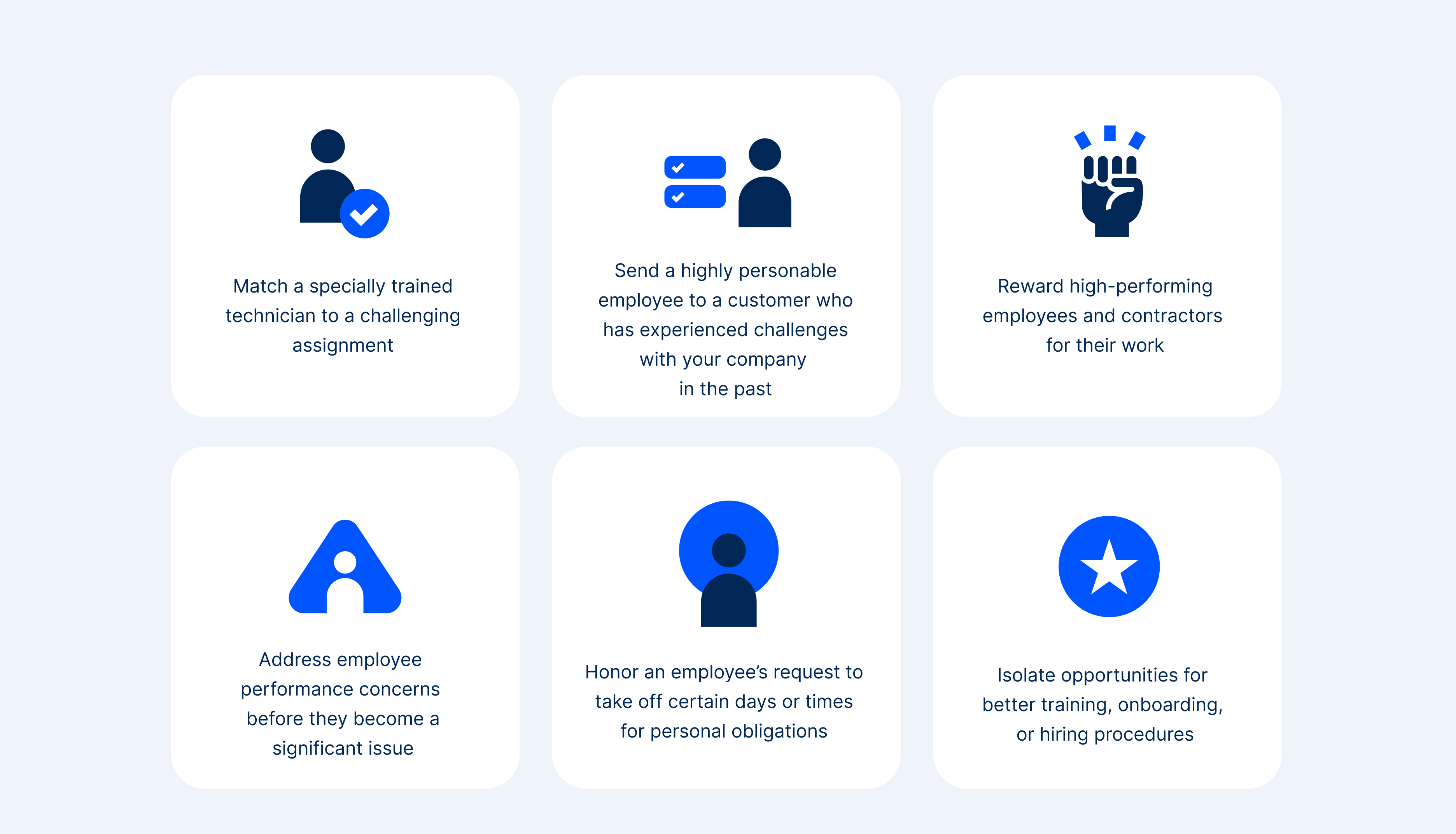How to Manage Highly Complex Field Service Work
Tackling sequential and multi-stage field service work
Multi-stage field service work is delivered in multiple discrete steps. It often involves dependencies that require the steps to be completed in a specific order.
Job dependencies come in many forms. Some dependencies are based on the service workflow, like an initial quote and a subsequent installation. Others are compliance-related, like an upfront audit followed by recurring safety inspections. Other dependencies come from specialized roles or team-based jobs: an urgent utilities project might require a civil engineer, excavator, pipefitter, and traffic control onsite at the same time.
Hiring and developing a highly skilled field service workforce
Excellent field service requires dispatching workers who are qualified and well-equipped to do the job. This is a complex effort that involves not only hiring and training the right people, but also identifying and dispatching the right worker(s) for each job.
Staff expertise is particularly important in the face of the ongoing labor shortage in field service. Experienced workers are retiring, and not enough new hires are entering certain types of field service to make up the difference. This labor gap is particularly worrying in certain fields—like healthcare, where nearly one in five workers left their roles between 2020 and 2023.
To maintain a well-qualified workforce, leaders must be prepared to:
- Hire excellent workers – identify and recruit highly qualified workers, and be efficient—by speeding up the hiring manager review, a healthcare company reduced lost candidates by 50%
- Provide a great onboarding experience – 3 in 10 employees who have a dissatisfactory onboarding experience expect to look for a new job within three months
- Offer ongoing learning and development – 8 in 10 people say learning adds purpose to their work, and it has an important effect on employee engagement and retention
Once the expertise is available in-house, it’s a matter of harnessing this expertise for the right jobs. This requires the right technology—especially for complex jobs and large field service workforces.
Field service management software uses workers’ certifications, licenses, skills, languages spoken, history with the customer, and other relevant qualifications to identify the pool of qualified workers. With this skill and certification matching, managers and schedulers can better understand their workforce and quickly assign (or reassign) jobs to a qualified person.
When you have a deep understanding of your workforce, you can:
This level of workforce visibility helps managers move on to the most important question: who is right for the job?
On its face, it seems simple: the worker has the skill, experience, equipment, and proximity to do the job well. But with advanced scheduling tools, “right for the job” means so much more: not only can the person deliver the service, but they are the right fit for the company’s strategic goals. This may be cost reduction, customer retention, staff utilization, or other organizational goals.
These factors vary from one company to another, and they can even change over time within the same organization. For example, a small home healthcare provider struggling to overcome the early-stage healthcare revenue cycle may prioritize the closest available worker and reduce costs. But as the company grows, adds more staff, and improves its financial position, it can prioritize other factors, like client satisfaction or workforce utilization.
The right field service technology should enable an organization to set enterprise-level goals to guide and even automate individual job assignments. As technology continues to advance, it will open up new ways for organizations to attract and engage highly skilled workers. In healthcare, for example, AI features can already help create optimal schedules, recruit top-notch healthcare providers, and streamline internal communication.
Practical tips to address staff expertise
- Provide meaningful professional development – provide onboarding, training, coaching, mentoring, job shadowing, and certification and licensing paths to upskill and cross-train workers in important areas
- Create an excellent onboarding experience – design a great onboarding program that introduces new hires to the company culture, processes, technology, and communication methods
- Collect and use workforce data effectively – choose technology solutions that integrate with other platforms (HR software, learning and development software, etc.) to provide one unified view of employees’ skills, qualifications, and availability
- Use skill and certification matching – implement smart scheduling tools that allow schedulers and managers to quickly (or automatically) identify workers that fit the job criteria
- Use mobile apps and clear workflows for technician enablement – empower mobile workers to access tech specs, troubleshooting workflows, blueprints, and other materials while on the job, as well as communicate with colleagues and their manager
Turning complex scheduling into an advantage
Scheduling is at the heart of field service complexity. Whether it’s multi-stage work, highly specialized work, or a high volume of jobs, scheduling is incredibly important.
Inefficient scheduling negatively affects field service operations in multiple areas: it drives down the number of jobs a worker can complete, drives up travel time and fuel costs, and results in workers being late, overbooked, or unprepared. These issues affect revenue, customer satisfaction, and the overall success of the field service team.
Scheduling matters to every field service operation—but in different ways:
When everyone is right for the job, you have a highly qualified workforce and/or a clearly defined scope of service that everyone can deliver. This is an excellent position to be in, and it’s an opportunity to accelerate growth by focusing on larger business goals. Think about what you’re trying to optimize for—customer retention, cost reduction, employee satisfaction, etc.—and implement a scheduling strategy that helps you prioritize these things, not just find open time slots. This strategy should include the business goals you want to optimize for, the metrics you will track to measure your progress, and how your team and your scheduling technology will work together to execute this plan.
Field service software should offer the tools to create a better work experience for your field teams. With the right platform, managers and schedulers can accommodate scheduling requests, assign work that aligns with company goals, and improve the employee experience—without disrupting customer service.
If your goal is cost reduction, find the most cost-effective employee for the job, and make sure your tools are designed to do so on an ongoing basis. Analyze KPIs like travel time, down time between appointments, and job completion time to understand the true cost of scheduling decisions.
If your goal is customer retention, think about how you can use scheduling to delight your customers: match customers with employees who have had positive interactions with them in the past, even if they are not the cheapest or closest option. If a particular customer has given negative feedback in the past, prioritize sending a highly qualified, personable worker who has higher-than-average customer feedback scores.
If your goal is employee development or retention, think about how your scheduling decisions impact your workforce and how you can make yourself a more attractive employer. For team-based jobs, pair newer workers with experienced colleagues to help them learn on the job and improve their skills. It’s not always possible, but when it is, use the scheduling system to accommodate workers’ preferences about the types of jobs and shifts they prefer.
When a select few workers are right for the job, leaders need to analyze the workforce (supply) and customer requests (demand). Take inventory of customers’ needs, compared to the skills, qualifications, experience, certifications, languages, and working hours available in your current workforce. This analysis will help you understand if these staffing gaps are a short-term issue or a fundamental challenge to your business. If you have the right mix of skills and availability, review your scheduling strategy and software to make the most of your specialized, in-demand staff. If you do not have the right mix of skills and availability, consider short-term solutions like contingent workers, as well as long-term solutions like specialized recruitment and professional development programs.
Consider the scheduling needs of an in-home healthcare provider. On a given day, a manager might receive new appointment requests for:
- A female nurse with experience in neonatal care
- A nurse specializing in geriatric medicine who can perform respiratory therapy
- A female nurse who can speak Korean
- A Certified Pediatric Nurse (CPN) who can speak Spanish
Without visibility into their workforce and a centralized place to organize all these details, it takes too long to assign work to the right people and it is far too easy to make consequential errors. Compare the manual scheduling process to a technology-assisted process:
Manual scheduling
- Ask around (by phone, by email, or in person) to see how many CPNs are on staff.
- Find out which CPNs speak Spanish.
- Shift around appointments to fit the new patient into the Spanish-speaking CPN’s schedule.
- Call the patient whose appointment was moved.
- Call the CPN who needs to take the new appointment.
- Send an updated schedule to everyone whose workday is affected.
Software-assisted scheduling
- Use the field service software to filter by role (CPN) and languages spoken (Spanish).
- Choose a nurse from the list who has a schedule opening at the appropriate time.
- Automatically send an appointment confirmation to the customer and an updated schedule to all impacted employees.
When no one is right for the job, it is a stressful situation for leaders, a disheartening experience for field service staff, and can lead to delays and disruptions in client service. This could be a long-term issue in which the business outgrew its initial scope or branched out into areas that employees are not equipped for. In other cases, it’s a short-term issue that highlights a new market opportunity or unique customer need. If you don’t have the right skill, certification, or equipment in-house for a certain job, quickly assess how this gap is impacting your business. If this is a core service your business needs to provide, start to engage contingent workers, partner organizations, or new hires who can augment your in-house workforce. If it’s not an essential service, work to communicate with affected customers and potentially refer them to another provider.
Take our home healthcare example again. A request comes in for a Spanish speaking Certified Pediatric Nurse (CPN), but this time, the manager knows that no one on staff is qualified for this appointment. There are a few ways to handle this staffing issue:
- Make plans to hire more staff that fits this need. The manager lays out a plan to hire CPNs and Spanish-speaking nurses. By the time they get approval on the hiring plan, post the jobs, conduct interviews, extend offers, perform background checks, and train the new employees, several weeks, at best, have passed since the initial request.
- Contract with other agencies and services. The manager reaches out to a healthcare agency that contracts out CPNs to other home health organizations. They work out a staffing support agreement so the manager can offer Spanish-speaking CPN services certain days every week.
In the midst of this difficult situation, a smart scheduling system gives you the data you need to quantify the impact of the problem. For example, with the right data, an administrator at the healthcare company discussed above can review:
- How many patients requested Spanish-speaking CPNs in the last month, quarter, etc.
- How many appointments were canceled or unfulfilled because of our lack of Spanish-speaking CPNs
- The financial impact of those missed appointments
- The potential value of being able to meet this need in the future (i.e. how many more patients could we serve by having Spanish-speaking CPNs on staff)
If it is a truly niche need, then it’s up to you to determine if the ROI is worth it. But if the need represents a larger opportunity in the marketplace, it may be worth contracting with someone who can perform the service on your behalf. This way, you can work to align your long-term staffing plan with these needs while still serving the customers who came to you in the first place.
Practical tips to handle complex scheduling requirements
- Use AI to schedule smarter – use AI in your field service strategy to automate simple scheduling tasks and optimize schedules according to costs, travel time, appointment capacity, or other factors
- Optimize travel routes between appointments – deliver the best route between jobs to improve schedule adherence and simplify day-to-day operations for mobile workers
- Track field service KPIs – track field service KPIs like schedule adherence, workforce utilization, time to schedule, etc. to review operations and make improvements
- Prioritize flexibility and agility in scheduling – schedule changes happen to almost everyone, and the most effective organizations can adapt quickly
- Review and optimize scheduling process – evaluate schedules and processes regularly to optimize scheduling operations
Collect data from multiple internal sources – effective scheduling should incorporate data from human resources (HR) software, enterprise resource planning (ERP), and other key systems
How Skedulo handles complex field service work
Skedulo is a mobile workforce management platform designed for complex work. Intelligent scheduling, an intuitive mobile app, customizable user interfaces, automated scheduling tools, and robust APIs make Skedulo a powerful tool for field service operations.
With Skedulo, field service leaders can:
- Ensure the right worker is assigned to the right job
- Reduce the time it takes to schedule with automated and intelligent scheduling
- Enable field workers with an easy-to-use mobile app
- Integrate customer info and service data from Salesforce, ServiceNow, Zendesk, and other platforms to create a unified data source for decision-making
See why G2 named Skedulo a Leader in Field Service Management for 21 consecutive quarters, or request a demo to see Skedulo for yourself!







